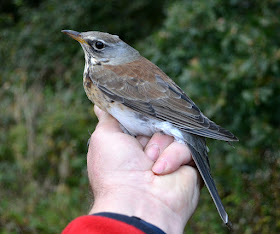 |
| Yesterday's 1cy female Sparrowhawk was the 7th Sparrowhawk to be ringed at the site this month. |
 |
| Today's female Blackcap was carrying a lot of fat and likely to be a late departing summer visitor rather than a recently arrived winter visitor. |
 |
| I know I have shown images of these grey headed continental Goldcrests before but this female, caught today, also had a long wing for a female of 56mm. |
 |
| Adult female Fieldfare. Not an easy bird to catch when on passage but always worth the effort. |
Top 5 for the month at Billinge were:
Redwing 739
Goldcrest 377
Song Thrush 59
Lesser Redpoll 36
Chiffchaff 28
Top 5 for the year to date at Billinge are:
Redwing 739
Goldcrest 666
Willow Warbler 367
Chiffchaff 340
Blackcap 219
What will November bring?




























